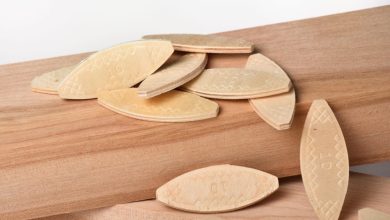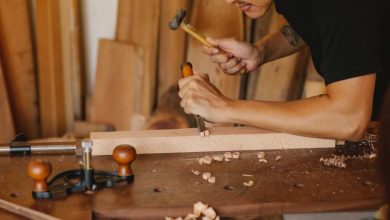What Are Biscuits in Woodworking
Biscuits in woodworking are small, crescent-shaped wooden pieces that are used to join two pieces of wood together.
They are inserted into slots created by a biscuit joiner, which is a woodworking tool that cuts the slots and glues the biscuits in place.
Biscuits are commonly used to join plywood and particle board, as well as align edges to create flush joints.
They come in different sizes and can be adjusted to cut slots at different angles.
Biscuits provide structural support and improve the strength of the bond between the wood pieces.
Did You Know?
1. Biscuits in woodworking, also known as plate or biscuit joinery, are small, oval-shaped wooden discs used to join two pieces of wood together, creating a strong and invisible connection.
2. The concept of using biscuits as a joining method was developed in Europe during the early 20th century as an alternative to traditional woodworking techniques such as doweling and mortise and tenon joints.
3. Biscuit joinery is commonly used in cabinet-making, furniture construction, and other woodworking projects where strength and alignment are crucial.
4. The biscuits themselves are typically made from compressed beech wood, which is known for its hardness and excellent resistance to swelling and shrinking.
5. When a biscuit is inserted into a joint, it absorbs moisture from surrounding glues, causing it to swell and fill the gap, enhancing the overall strength and stability of the joint.
What Is A Biscuit Joiner And How Does It Work?
A biscuit joiner, also known as a plate joiner, is a versatile woodworking tool used to join two pieces of wood together. It achieves this by cutting crescent-shaped holes in the edges of the wood or wood composite panels. The joiner utilizes a small circular saw blade specifically designed for biscuit joinery.
The process starts by adjusting the depth of the cut on the joiner to match the size of the biscuit. Once activated, the blade precisely cuts the crescent-shaped hole on one edge of each wood piece that is to be joined. The two pieces are then aligned, clamped together, and a wooden biscuit is covered with glue before being placed in the slot created by the joiner. The wet glue expands the biscuit, enhancing the bond between the wood pieces.
This method of joinery was invented in 1956 by Hermann Steiner in Liestal, Switzerland. It is favored by woodworkers for its simplicity and effectiveness in providing strong and reliable connections between wood pieces, resulting in sturdy and seamless joints.
Use Of Biscuits In Woodworking Applications
Biscuits are primarily used in woodworking to join sheet goods such as plywood and particle board. They are particularly useful when aligning the edges of workpieces to create flush joints, where the surfaces of the joined pieces are perfectly level and even with each other. This technique is commonly employed in cabinet making, furniture construction, and other woodworking projects where tight and precise connections are crucial.
In addition to their primary function as joining aids, biscuits can serve other purposes in woodworking applications. Some manufacturers offer specialized biscuits that are designed for specific applications, such as furniture hinges or slide-in connectors. These biscuits are shaped and sized to fit perfectly in the intended areas, providing additional support and stability where needed.
Different Sizes And Types Of Biscuits
Biscuits are woodworking tools used to join wood pieces together. They come in various sizes, including both metric and inch measurements. Some manufacturers even offer their own proprietary sizes.
Standard biscuits are commonly used in general woodworking projects. They are available in dimensions such as 16 × 5.6 × 2.4 mm (5⁄8 × 7⁄32 × 3⁄32 inches), 19 × 7.1 × 2.4 mm (3⁄4 × 9⁄32 × 3⁄32 inches), and 25.4 × 12.7 × 2.4 mm (1 × 1⁄2 × 3⁄32 inches). These biscuits provide reliable structural support.
For smaller woodworking applications, detail biscuits are available. Although they are smaller in size, they still serve their purpose. Common dimensions for detail biscuits include R1: 16 × 5.6 × 2.4 mm (5⁄8 × 7⁄32 × 3⁄32 inches), R2: 19 × 7.1 × 2.4 mm (3⁄4 × 9⁄32 × 3⁄32 inches), and R3: 25.4 × 12.7 × 2.4 mm (1 × 1⁄2 × 3⁄32 inches).
- Biscuits come in various sizes including metric and inch measurements
- Some manufacturers have their own proprietary sizes
- Standard biscuits are commonly used in general woodworking projects
- Available dimensions for standard biscuits include 16 × 5.6 × 2.4 mm, 19 × 7.1 × 2.4 mm, and 25.4 × 12.7 × 2.4 mm
- Detail biscuits are smaller in size and are used for smaller woodworking applications
- Available dimensions for detail biscuits include R1: 16 × 5.6 × 2.4 mm, R2: 19 × 7.1 × 2.4 mm, and R3: 25.4 × 12.7 × 2.4 mm
“Biscuits come in various sizes to accommodate different woodworking requirements.”
Features And Specifications Of Portable Plate Joiners
Portable plate joiners are compact and lightweight versions of biscuit joiners, designed for ease of use and convenience. They typically feature a 4-inch or 100 mm diameter blade that can accommodate different sizes of biscuits, such as #0, #10, and #20. The depth of the cut can be adjusted to accommodate the size of the biscuit being used and the requirements of the woodworking project.
The blades used in portable plate joiners usually have 4, 6, or 8 teeth, which allow for quick and precise cutting. The blades fit onto a 7⁄8 inch or 22 mm arbor, ensuring secure and stable attachment. The thickness of the blade is typically around 0.156 to 0.160 inch or approximately 4 mm.
Portability and convenience are key features of these tools, making them ideal for carpenters and woodworkers who need to work on-site or in tight spaces. They offer flexibility in terms of cutting angles, enabling slots to be cut at angles other than 90 degrees.
- Compact and lightweight design
- Accommodates different sizes of biscuits
- Adjustable depth of cut
- Quick and precise cutting with 4, 6, or 8 teeth blades
- Secure and stable attachment with 7⁄8 inch or 22 mm arbor
- Portability and convenience for on-site or tight space work
- Flexibility in cutting angles for various woodworking needs
Portable plate joiners are a versatile tool that offers convenience and precision for carpenters and woodworkers. Their compact and lightweight design, adjustable depth of cut, and various blade options make them suitable for a range of woodworking projects. With its ability to cut slots at different angles, this tool adds flexibility to create unique and innovative pieces.
Clarifying Biscuit Terminology And Dimensions
Biscuits, commonly known as plates in woodworking, can sometimes cause confusion due to standard dimensions and terminology. One aspect that requires clarification is the thickness of the biscuit. The standard cutter width is usually 4 mm, indicating that the biscuit’s thickness is likely to be around 3.75 mm.
It is crucial for woodworkers to be familiar with these specifics in order to achieve accurate and precise joinery. A solid understanding of biscuit dimensions and terminology enables woodworkers to choose the appropriate size for their projects, resulting in strong and dependable connections between wood pieces.
Check this out:
Frequently Asked Questions
What is the method of biscuits?
The method of making biscuits involves mixing dry ingredients together without the need for any additional tips. The next step is to incorporate fat into the mixture by cutting it in, which can be somewhat challenging. Once the fat is evenly distributed, liquid is mixed in using a fork. Afterward, the dough is kneaded by folding it in half, and then rolled out to a thickness of about one inch, either using a rolling pin or by patting it with hands. Finally, the biscuits are cut into the desired shape, completing the method of making biscuits.
1. How are biscuits used in woodworking joinery and why are they considered a useful technique?
Biscuits, also known as biscuit joints, are commonly used in woodworking joinery as a method to join two pieces of wood together. Biscuits are small, oval-shaped pieces of compressed wood, typically made from beechwood, that are inserted into slots created in the wood. These slots are made using a special biscuit joiner tool.
Biscuits are considered a useful technique in woodworking for a few reasons. Firstly, they provide added strength and stability to the joint by increasing the surface area for glue to bond the two pieces of wood together. This results in a stronger and more secure joint. Secondly, biscuits are relatively easy to use and can be done by both skilled woodworkers and beginners. They can also be used in various woodworking projects, including cabinets, furniture, and flooring, making them versatile and practical for many applications. Overall, biscuits help streamline the joining process by providing a reliable and efficient method for connecting wood pieces.
2. What are some common applications of biscuit joinery in woodworking projects?
Biscuit joinery is a common technique used in woodworking projects to join two pieces of wood together. It involves using small oval-shaped wooden biscuits that are inserted into slots cut in the mating edges of the wood pieces. Biscuit joints are typically used for alignment and added strength rather than relying solely on glue.
Some common applications of biscuit joinery include cabinet making, furniture construction, and trim work. In cabinet making, biscuit joints are used to join the sides, tops, and bottoms of cabinets, providing stability and creating seamless and flush connections. In furniture construction, biscuit joinery is commonly employed for creating strong and durable connections between table tops, chair legs, and other furniture components. Additionally, biscuit joinery is often utilized in trim work, such as when installing crown molding, baseboards, or picture frame moldings, to achieve precise and tight joints for a finished and polished look. Overall, biscuit joinery serves as a versatile and reliable method for enhancing the structural integrity and aesthetic appeal of various woodworking projects.
3. Can biscuit joinery be used effectively with different types of wood, or are there specific wood species that are better suited for this technique?
Biscuit joinery can be used effectively with different types of wood. However, certain wood species may have better suitability for this technique. Softwoods like pine or cedar, as well as moderately dense hardwoods like oak or maple, are commonly used for biscuit joinery due to their ability to absorb and hold the biscuits securely. These woods have more porous and absorbent properties which allow them to create strong joints when the biscuits are glued in place. On the other hand, extremely dense or oily woods, like teak or rosewood, may not be as well-suited for biscuit joinery due to their limited ability to absorb glue and create strong bonds. Nonetheless, by adjusting the size of the biscuit and employing proper techniques, biscuit joinery can still be used effectively with a variety of wood species, even those with less ideal characteristics.

